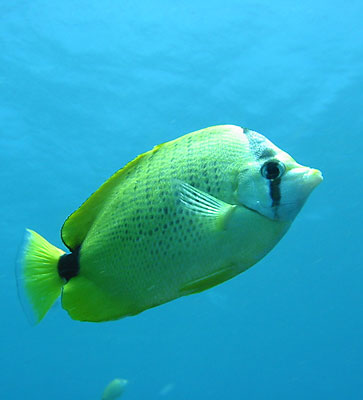
| Sea creature browser: |
 Turtles |
 Triggerfish |
 Tang |
 Surgeonfish |
 Moray eels |
 Butterfly fish |
 Parrotfish |
 Goatfish |
 Jellyfish |
 Urchins |

Butterfly Fish
One of the most prominent fish in the Hanauma Bay region is the Milletseed Butterfly Fish (in picture). This particular type of butterfly fish is seen only in Hawaii and is well-known in the Hanauma Bay region.
Like other butterfly fish, the Milletseed Butterfly fish is flat and tall, making it simple for the fish to swim in and out of crevices within the coral reefs. At maximum, Milletseed Butterfly fish are 6 inches in length. They have gently rounded bodies, slightly concave foreheads and short fins.
Milletseed Butterfly fish are primarily yellow in color with blue markings around their eyes and mouth. The yellow/tan body of the fish is speckled with black dots. This makes it easy for the fish to camouflage itself. The dots are arranged in vertical rows. Another camouflage trick is the dark black spot at the base of the fish’s tail. This confuses predators who can’t distinguish this spot from the fish’s actual eye.
Butterfly Fish Habits
You’ll find Milletseed Butterfly fish traveling in schools. They feed on the coral polyps in the reef and the sea anemones. While snorkeling at Hanauma Bay, you will see them darting in and out of the coral formations and looking for their next meal. They stick primarily to shallower waters, under 18 meters, so the bay is the perfect place to find them.
Milletseed Butterfly fish also tend to stick to one “home range.” That’s why you’ll find so many in the bay. They prefer to keep to one area where they know there is a food supply, rather than swimming elsewhere. Butterfly fish are diurnal, meaning that they are most active during the day. Daytime snorkelers will have no problem finding active schools of these fish. Toward dusk, the fish will settle in reef recesses and become inactive for the night.